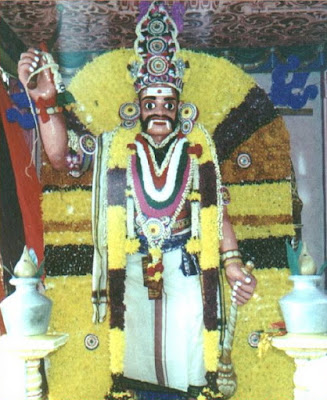Muneeswarar also called Muneeswaran is a Hindu God who is considered the incarnation of Lord Shiva. ‘Muni’ means ‘saint’ and ‘iswara’ refers to God; Shiva in this case. Shaivite families who worship the lord, consider him a family deity. Several mythological and religious stories are attached to the God and he appears very different from what traditionally Hindu Gods and deities are made to appear.
Mythological Significance
Lord Shiva’s wife, Sati was the daughter of Daksha, who was the chief of the Gods. Daksha was not particularly inclined towards Shiva, however Sati grew upon to have her heart on him and desired to marry Shiva. A swayamvara was arranged for her where Daksha had invited all the Gods except for Shiva. Sati cast the garland on the air desiring Shiva to have it around him. There at the middle of the crowd, Shiva stood with the garland around his head and thus Daksha had to get his daughter married to him. On the occasion of horse sacrifice when Daksha invited all the gods except for Shiva, Sati felt insulted and took her life at Daksha’s feet. This anger Shiva and it burned his senses. Out of ignited rage he created Virabhadra who was tremendous, colossal, deadly with monstrous rage. He had a frightening appearance and Shiva ordered him to plunder Daksha’s horse sacrifice and destroy everything. When Virabhadra polluted the offerings in the ceremony, wrecked havoc and finally cut off Daksha’s head, Shiva created Muneeswara to protect the souls. He is said to be the possessor of seven qualities which attributes him with seven names.
Cultural popularity
Muneeswarar enjoys great popularity among Shiva devotees as the harbinger of peace. However, he is also worshipped as a fierce god who is offered lamb meat and chicken as offerings. The stories attached to him in Hindu religious stories are extremely popular in India, Singapore and Malaysia. Several Indian states have temples where they worship Muneeswaran. The weapons of the avatar include the trident, the mace, and the sword. Typically in all Muneeswarar temples, a trident is placed on the ground where it pieces of lime are offering to it. Temples in certain parts of India where the deity does not have an idol, a laid stone is used for worshipping. In certain places the statue is painted in black while in other places they use black granite to construct the idol. A dhoti and turban adorns the God unlike embellished clothing used on other Gods.
Mythological Significance
Lord Shiva’s wife, Sati was the daughter of Daksha, who was the chief of the Gods. Daksha was not particularly inclined towards Shiva, however Sati grew upon to have her heart on him and desired to marry Shiva. A swayamvara was arranged for her where Daksha had invited all the Gods except for Shiva. Sati cast the garland on the air desiring Shiva to have it around him. There at the middle of the crowd, Shiva stood with the garland around his head and thus Daksha had to get his daughter married to him. On the occasion of horse sacrifice when Daksha invited all the gods except for Shiva, Sati felt insulted and took her life at Daksha’s feet. This anger Shiva and it burned his senses. Out of ignited rage he created Virabhadra who was tremendous, colossal, deadly with monstrous rage. He had a frightening appearance and Shiva ordered him to plunder Daksha’s horse sacrifice and destroy everything. When Virabhadra polluted the offerings in the ceremony, wrecked havoc and finally cut off Daksha’s head, Shiva created Muneeswara to protect the souls. He is said to be the possessor of seven qualities which attributes him with seven names.
Cultural popularity
Muneeswarar enjoys great popularity among Shiva devotees as the harbinger of peace. However, he is also worshipped as a fierce god who is offered lamb meat and chicken as offerings. The stories attached to him in Hindu religious stories are extremely popular in India, Singapore and Malaysia. Several Indian states have temples where they worship Muneeswaran. The weapons of the avatar include the trident, the mace, and the sword. Typically in all Muneeswarar temples, a trident is placed on the ground where it pieces of lime are offering to it. Temples in certain parts of India where the deity does not have an idol, a laid stone is used for worshipping. In certain places the statue is painted in black while in other places they use black granite to construct the idol. A dhoti and turban adorns the God unlike embellished clothing used on other Gods.

Comments
Post a Comment